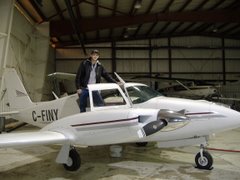I'll continue with our aero engine discussion. This time I'll focus on reliability issues. It goes without saying that the stakes are much higher for airplanes then then are for any other form of powered travel when it comes to the reliability of engines. They just have to work. When engingeering something for reliability, there's two approaches you can take. The first is to make things as mechanically simple as possible - the less things on the engine there are to break, the less often it will break. You can also approach it from the point where if the first option won't work, you need to create redundancy in the system so when something does break, something else is in place to take over.
Aero engines are I supposed a comprimise between the two, but they definitely lean more towards the simplicity approach. The simplicity approach also has its advantages in the weight department. The less stuff there is tacked onto the engine, the lighter it will be, and that's a critical factor when designing airplanes.
Lets take for example the cooling system on an airplane... oh wait, there isn't one. Well not like a car has one at least. A car has a system of tubes that run liquid through the hot parts of the engine to absorb the heat. The liquid is then piped through a radiator, which cools the liquid by allowing the heat to vent into the air. A liquid coolant system works remarkably well in regulating engine temperature, but how many times over your life have you been driving and had your car overheat? It doesn't happen often, but it does happen - coolant leaks out, rad caps burst, whatever. You pull over to the side of the road. Aero engines are completely air cooled. Its quite simple to explain actually. Aircraft engines are fitted with baffling systems to take in ram air from the plane moving forward and the prop blowing air into the cowl, and direct it over the cylinders to cool it down. Some of the more complex airplanes, like the Twin Comanche, have cowl flaps. These are doors out the back of the engine that can be manually opened and closed to allow the air in the cowl to be flushed out the back of the engine. This keeps fresh constant airflow over the engine, which results in better cooling. We use this in situations where the engine is either working very hard (like takeoff and landing) and needs extra cooling, or during ground operations when the speed of the aircraft isn't great enough to allow enough airflow over the engines. That's all there is to it. I would be hard pressed to explain anything else about aero engine cooling. The cooling system I'd say is pretty reliable, air doesn't break down.
An example of a system that takes the opposite engineering approach would be the magnetos. Magnetos could be described as something along the lines of an ignition coil, alternator, and distributer all wrapped up in one. Magnetos are driven by a shaft directly off the engine. This shaft turns a coil which generates voltage and delivers it to the required spark plug. Magnetos are really nice because they have no connection to any other system on the airplane, so are dependant only on themselves to keep working. In a car, the distributer is dependant on the coil to produce the spark, which is dependant on the battery for its charge, which is dependant on the alternator to continue charging the battery. The magneto bypasses this long line of fallable equipment, so as long as the magneto is working properly, the engine will still run. The magneto is relatively small, only about the size of both your fists stacked on top of each other, but its not simple. So the engine is equipped with two magnetos. Each magneto has its own set of spark plugs running into the engine, and the engine is capable of running on only one magneto. So a four cylinder engine actually has 8 spark plugs. This provides excellent redundancy, as well as better fuel combustion.
The oil systems are virtually the same as cars. There are two different types, the wet sump system, and the dry sump system. A wet sump is simply oil sitting in an oil pan under the engine, which sloshes up and lubricates the pistons. A dry sump is a system where the oil is stored in a resevoir seperate from the engine, and is then pumped through to the parts needing lubrication. Most piston engines use a wet sump system for reasons of simplicity, lightweight, and low cost.
Everything else on the engine is pretty basic once you learn it. There are the accessories driven off the engine like the alternator, vacuum pump (which power some of our cockpit instruments), and fuel pumps on more complex aircraft. For the most part these are all simply bolt on components, similar to a car.
All in all aero engines are incredibly simple compared to their groundbased counterparts. With the exception of a couple brand new airplanes there are no fancy computer parts, no over-engineering. Just a simple, robust piece of machinery.
Subscribe to:
Post Comments (Atom)




Robust indeed. Forty year old engines that purr like a kitten are a beautiful thing, notwithstanding all the maintenance time put into them.
ReplyDeleteI like the explanation of simplicity vs redundancy and the examples. You're going to make a fine teacher, Chad.